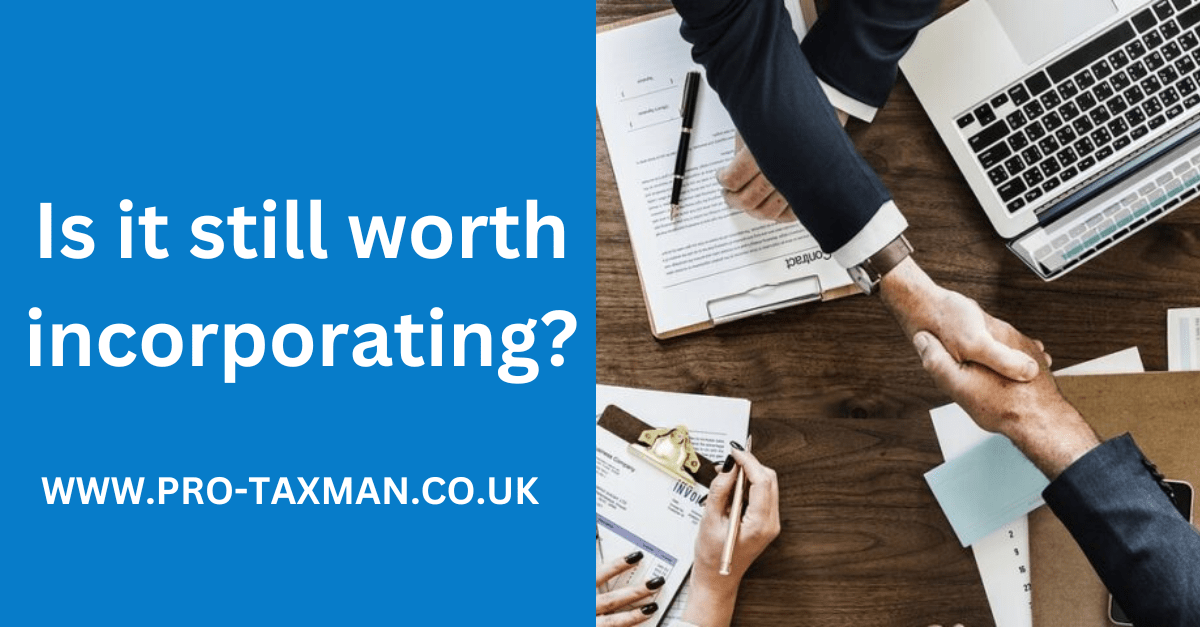For many years, working out whether tax savings could be achieved by incorporation was relatively straightforward. Once profits reached a particular level, transferring the trade to a limited company and using profit extraction strategies would save a lot of money; the larger the profits, the bigger the saving. This all changed in 2016 with notional tax credits for dividends being abolished such that the question of whether to incorporate depended on a combination of factors. Now with the increase in dividend tax rates as from April 2022 the question as to whether to incorporate (or disincorporate) has even more relevance as in certain instances it is more tax efficient to operate as a sole trader or in a partnership. However, tax savings can still be achieved particularly if there is more than one director-owner and if not all profits are withdrawn. As ever it all depends on the calculations.
Tax savings on incorporation
When you are looking to work out whether incorporation is financially worthwhile, you are looking at the income tax situation for the individual director-owner and the corporation tax liability to give a total tax saving figure. The table below shows the savings per level of income. The calculation assumes that all profit is withdrawn.
Example 1 – Income gains on incorporation
2022/23
Profit Sole trader net Company owner net Extra
after tax and NIC after tax and NIC received
£ £ £
£20,000 17,520 17,810 290
£30,000 24,495 25,201 706
£40,000 31,470 32,592 1,122
£50,000 38,445 39,983 1,538
£60,000 44,156 47,312 3,156
£70,000 49,830 52,678 2,848
£80,000 55,505 58,045 2,540
£90,000 61,180 63,411 2,231
£100,000 66,856 68,777 1,921
£125,000 76,043 81,554 5,511
£150,000 90,203 90,413 210
£200,000 116,078 116,078 nil
The table shows that as a ‘rule of thumb’ if all profits are to be withdrawn and the Employment Allowance is not available (as would usually be the case with a sole director-employee) then for 2022/23 incorporation is generally not worthwhile for profits under £40,000 (bearing in mind the additional work and cost involved in preparing more detailed accounts, running a payroll and submitting additional returns to both Companies House and HMRC). However, once profit exceeds £60,000, the situation changes in favour of incorporation. The savings figure then drops at £70,000 profit, becoming exactly level at £200,000, due to the large ‘jump’ in the higher dividend rate of 33.75% in comparison with the basic rate of 8.75% and, importantly, the abatement of the personal allowance on income over £100,000. The tax savings reaches highest if the profit is £125,000 because at this profit, all the personal allowance of £12,570 for a self-employed taxpayer is cancelled. In contrast, a company profit of £125,000 means a dividend and salary available of £103,170 – allowing £10,985 personal allowances to be deducted.
Other considerations
There are various reasons why the above figures should be used as a guide only. The main one being that they assume all the profit is withdrawn which is not the case with many companies. Pension contributions can be a valuable method of extracting profits with no personal tax implications for the director-owner and tax relief for the company.
In addition, the calculations assume a sole director-shareholder but if the company could be set up with a spouse or civil partner then including two personal allowances, two basic rate bands and two dividend allowances in the mix could still yield large savings.
When deciding whether to incorporate it should not be forgotten that there are other vehicles of operation that may produce higher tax savings in comparison. A partnership could be a more tax-efficient option for those who are married or civil partners because of the availability of double personal allowance and double basic rate band (assuming that there is no other income). However, bearing in mind the protections offered as a company may lead the owner to look at setting up a limited liability partnership.
Finally, it must be said that the above figures could all change in the next few weeks as whoever is the new incumbent of Number 10 may reduce tax rates or National Insurance contributions in the next ’emergency budget’.
Need professional accounting service or accounting advice? Contact us to book a 15-min Free Consultation with us today.
To find out more please follow us on Facebook, Twitter, or LinkedIn. Feel free to contact us on 0333 006 4847 or request a call back by texting 075 6464 7474

